高中英语学业水平测试复习专题二阅读理解题型细节理解题课件
文档属性
| 名称 | 高中英语学业水平测试复习专题二阅读理解题型细节理解题课件 |  | |
| 格式 | ppt | ||
| 文件大小 | 1.5MB | ||
| 资源类型 | 试卷 | ||
| 版本资源 | 通用版 | ||
| 科目 | 英语 | ||
| 更新时间 | 2025-03-17 09:44:51 | ||
图片预览

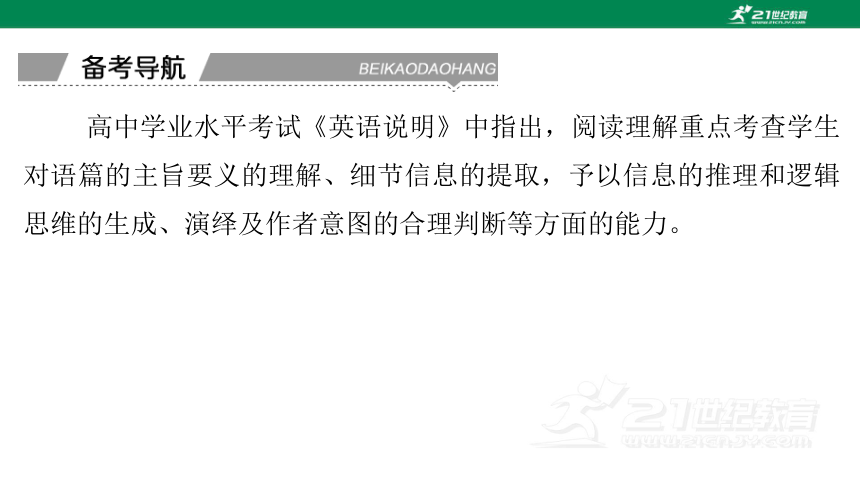
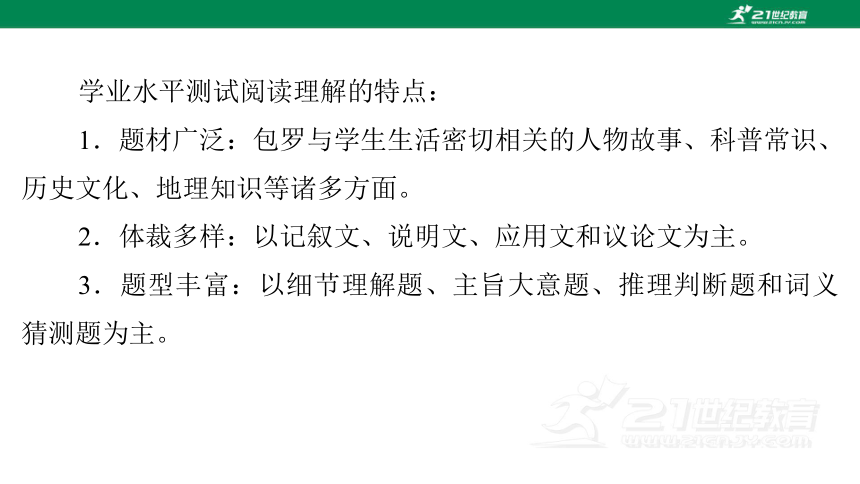
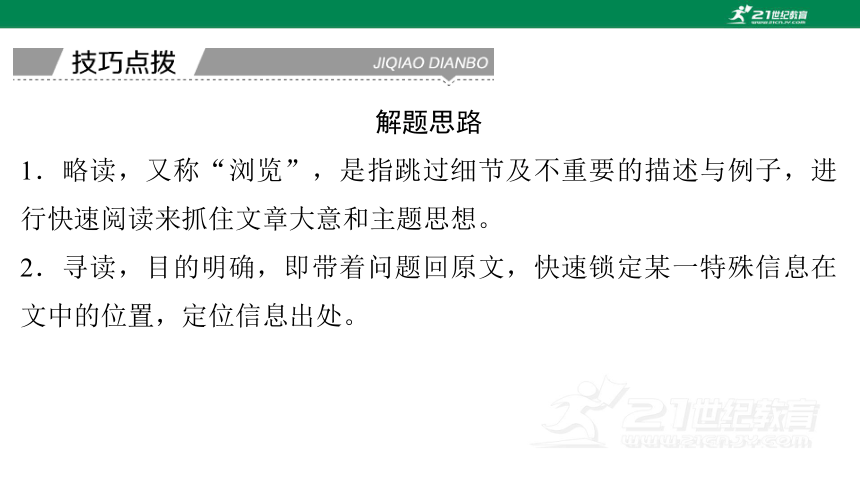
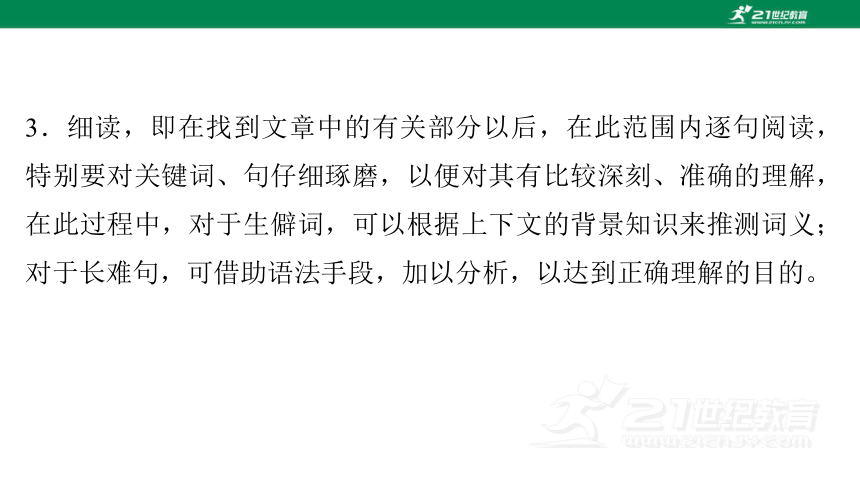



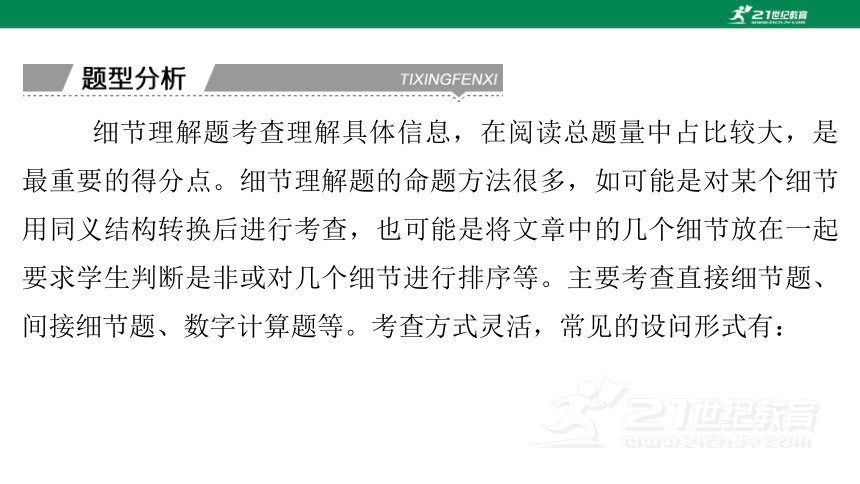
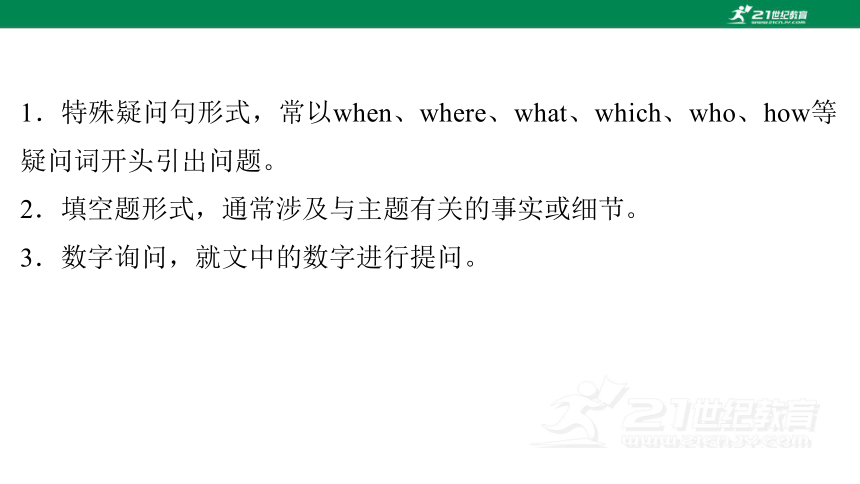

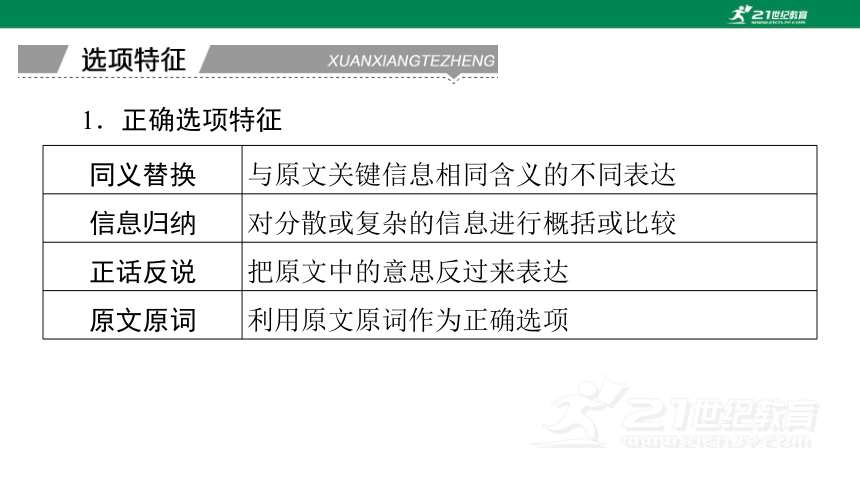
文档简介
(共42张PPT)
专题二 阅读理解
高中学业水平考试《英语说明》中指出,阅读理解重点考查学生对语篇的主旨要义的理解、细节信息的提取,予以信息的推理和逻辑思维的生成、演绎及作者意图的合理判断等方面的能力。
学业水平测试阅读理解的特点:
1.题材广泛:包罗与学生生活密切相关的人物故事、科普常识、历史文化、地理知识等诸多方面。
2.体裁多样:以记叙文、说明文、应用文和议论文为主。
3.题型丰富:以细节理解题、主旨大意题、推理判断题和词义猜测题为主。
解题思路
1.略读,又称“浏览”,是指跳过细节及不重要的描述与例子,进行快速阅读来抓住文章大意和主题思想。
2.寻读,目的明确,即带着问题回原文,快速锁定某一特殊信息在文中的位置,定位信息出处。
3.细读,即在找到文章中的有关部分以后,在此范围内逐句阅读,特别要对关键词、句仔细琢磨,以便对其有比较深刻、准确的理解,在此过程中,对于生僻词,可以根据上下文的背景知识来推测词义;对于长难句,可借助语法手段,加以分析,以达到正确理解的目的。
题型1 细节理解题
题型分析
PART
01
第一部分
细节理解题考查理解具体信息,在阅读总题量中占比较大,是最重要的得分点。细节理解题的命题方法很多,如可能是对某个细节用同义结构转换后进行考查,也可能是将文章中的几个细节放在一起要求学生判断是非或对几个细节进行排序等。主要考查直接细节题、间接细节题、数字计算题等。考查方式灵活,常见的设问形式有:
1.特殊疑问句形式,常以when、where、what、which、who、how等疑问词开头引出问题。
2.填空题形式,通常涉及与主题有关的事实或细节。
3.数字询问,就文中的数字进行提问。
选项特征
PART
02
第二部分
1.正确选项特征
同义替换 与原文关键信息相同含义的不同表达
信息归纳 对分散或复杂的信息进行概括或比较
正话反说 把原文中的意思反过来表达
原文原词 利用原文原词作为正确选项
2.干扰选项特征
张冠李戴 是原文信息,但不是题目要求的内容
无中生有 符合常识,但不是文章的内容
曲解文意 极其相似但是细节处与原文有出入
颠倒是非 在意思上与原文大相径庭或者完全相反
正误参半 部分正确,部分错误
技巧点拨
PART
03
第三部分
1.直接细节题——题干定位巧比对
【题型特点】 直接细节题主要针对文中涉及的某个具体事物、人物、时间、地点、原因、结果等提问。
【图解技巧】
2.间接细节题——语义转换善概括
【题型特点】 间接细节题是直接信息的转述、原文信息的间接表达、直接信息背后隐含内容的表达。
【图解技巧】
3.数字计算题——加减乘除巧破解
【题型特点】 此类试题要求考生对具体细节信息,尤其是对相关的时间、数量等数字和信息进行分析和理解,利用加、减、乘、除等运算方法进行计算,但此类试题重点不在于计算,而在于考查考生对具体细节信息的处理能力,因此考生在解题时必须找出计算背后所隐含的信息。
【图解技巧】
专题训练
PART
04
第四部分
Passage 1
(2022·广东1月)George Daniels lives in London. He is a watchmaker. His work continues the tradition of the English watchmakers of the 18th and 19th centuries. Today this tradition is almost dead. Daniels is the only man in the world who designs his own watches, makes all the parts himself, and then puts them together.
A Daniels watch is the product of his hands alone. One of his watches, which is now in an American museum, took 3,500 hours to complete. He usually makes one watch a year. Each one is inscribed(刻)with “Daniels London” and costs about $10,000. Of course, these are not ordinary watches—they are very beautiful and will last three centuries.
George Daniels has always been attracted by clocks and watches. When he was five, he used to take his father's clock apart, and put it back together again. At school he used to repair his teachers' watches.
He is now internationally famous and many people would like him to make watches for them. But most of them will be disappointed. He chooses his customers very carefully indeed. “It must be someone who understands the subject,” he says, “not someone who will leave the watch in the drawer and only show it to dinner guests.”
【语篇解读】 本文是一篇记叙文。文章讲述了一位著名的钟表匠乔治·丹尼尔斯。他自己设计手表,亲手制作所有的零件,在国际上颇有名声。然而,不是所有人都能获得让他帮忙制作手表的资格,他只给那些懂得手表的人设计。
1.Who is George Daniels
A.One of the few who repaired watches in the old days.
B.The only man who collects old watches in the world.
C.One of the few remaining watch designers in the world.
D.The only man who designs and makes watches by himself.
√
细节理解题。根据第一段最后一句“Daniels is the only man in the world who designs his own watches, makes all the parts himself, and then puts them together.”可知,丹尼尔是唯一一个自己设计并且制作手表的人。
2.How long can a Daniels watch keep working
A.10,000 hours. B.300 years.
C.200 years. D.3,500 hours.
细节理解题。根据第二段最后一句“Of course, these are not ordinary watches—they are very beautiful and will last three centuries.”可知,手表可以工作300年。
√
3.Which of the following shows Daniels' early interest in watches
A.He played with his father's clock.
B.He taught people how to repair watches.
C.He made a watch for an American museum.
D.He made beautiful and long -lasting watches.
细节理解题。根据第三段中的“When he was five, he used to take his father's clock apart, and put it back together again.”可知,小时候玩父亲的钟时,他便展示出了兴趣。
√
4.George Daniels makes watches for those who ________.
A.can afford his watches
B.may want to show them to others
C.appreciate his watches
D.enjoy his watch making process
细节理解题。根据最后一段的最后一句“‘It must be someone who understands the subject,’ he says, ‘not someone who will leave the watch in the drawer and only show it to dinner guests.’”可知,乔治·丹尼尔斯为那些能够欣赏他的手表的人服务。
√
5.What do we know about Daniels' watches
A.Only a few people like them.
B.They are kept in a museum.
C.Only a few people can get them.
D.They have a history of over 200 years.
细节理解题。根据最后一段中的“But most of them will be disappointed. He chooses his customers very carefully indeed.”可知,只会有少部分人能够得到手表。
√
Passage 2
Last year, wildfire spread through Boulder, Colorado. It wasn't a hot summer day. It wasn't a forested neighborhood. It was winter in the suburbs (郊区). More than 1,000 homes and buildings burned.
Large parts of the country that don't have wildfires are now at risk. They include nearly 80 million homes and buildings. That's what new data shows. Over the next 30 years, the risk will only grow. The group First Street Foundation created a program called Fire Factor. People can go to a website to learn what their wildfire risk is in 2022 and in 2052. Right now, about 16% of Americans live in risky places. By 2052, that will go up to 21%.
California will likely suffer a lot from wildfire. That's partly because it is so big and partly because of its weather. So California will be on the top of the at- risk list. But nearly half of all at- risk Americans in 2052 will live in the southern half of the U.S. The South will be home to the largest number of people at high risk: 32 million. States like Texas, Florida, Oklahoma, and North and South Carolina will be “in the line of fire,” so to speak, and so will southwestern states like Arizona and New Mexico.
People are doing many things to make fire risk worse. They are moving to places where wildfire is a natural yearly event. They are building homes right next to plants and trees that can burn. Climate change has increased heat and dryness. That means any spark (火花) at any time can cause a big fire.
As with many climate threats, wildfires put minorities (少数群体) at the greatest risk. By 2052, about 44% of all Native Americans will live in places at major risk from wildfire. Nearly 1 in 4 Hispanics will. People who don't speak English or own cars will have a harder time learning about and getting away from a fast -moving fire.
1.What problem did Boulder have last year
A.Strange weather.
B.Huge loss of forests.
C.Widespread wildfires.
D.A rapid drop in populations.
细节理解题。根据第一段中的“Last year,wildfire spread through Boulder Colorado.”和“More than 1,000 homes and buildings burned.”可知,博尔德市遭遇了大面积的野火。
√
2.What does the new data show
A.About 16% of Americans are safe now.
B.The risky areas of wildfire are increasing.
C.The risk of wildfire will be lowered in 2052.
D.Nearly 80 million homes are burnt down by wildfire.
√
细节理解题。根据第二段中的“Large parts of the country that don't have wildfires are now at risk. They include nearly 80 million homes and buildings. That's what new data shows. Over the next 30 years,the risk will only grow.”可知,新的数据表明野火的危险区域正在增加。
3.Which of the following will be the most dangerous in 2052
A.Florida. B.South Carolina.
C.California. D.New Mexico.
细节理解题。根据第三段中的“California will likely suffer a lot from wildfire. That's partly because it is so big and partly because of its weather. So California will be on the top of the at- risk list.”可知,到2052年,加州将是最危险的。
√
√
4.What is paragraph 4 mainly about
A.Reasons why wildfire risk is worse.
B.Dangers humans may face in the future.
C.Actions taken by humans to prevent fire.
D.Suggestions for self protection in wildfire.
段落大意题。根据第四段内容可知,本段的主要内容是介绍了野火风险加剧的原因。
√
5.How many Hispanics will live in risky places by 2052
A.About 16%. B.About 21%.
C.About 25%. D.About 44%.
细节理解题。根据最后一段中的“By 2052,about 44% of all Native Americans will live in places at major risk from wildfire. Nearly 1 in 4 Hispanics will.”可知,到2052年,将有25%的西班牙裔人生活在危险地区。
专题二 阅读理解
高中学业水平考试《英语说明》中指出,阅读理解重点考查学生对语篇的主旨要义的理解、细节信息的提取,予以信息的推理和逻辑思维的生成、演绎及作者意图的合理判断等方面的能力。
学业水平测试阅读理解的特点:
1.题材广泛:包罗与学生生活密切相关的人物故事、科普常识、历史文化、地理知识等诸多方面。
2.体裁多样:以记叙文、说明文、应用文和议论文为主。
3.题型丰富:以细节理解题、主旨大意题、推理判断题和词义猜测题为主。
解题思路
1.略读,又称“浏览”,是指跳过细节及不重要的描述与例子,进行快速阅读来抓住文章大意和主题思想。
2.寻读,目的明确,即带着问题回原文,快速锁定某一特殊信息在文中的位置,定位信息出处。
3.细读,即在找到文章中的有关部分以后,在此范围内逐句阅读,特别要对关键词、句仔细琢磨,以便对其有比较深刻、准确的理解,在此过程中,对于生僻词,可以根据上下文的背景知识来推测词义;对于长难句,可借助语法手段,加以分析,以达到正确理解的目的。
题型1 细节理解题
题型分析
PART
01
第一部分
细节理解题考查理解具体信息,在阅读总题量中占比较大,是最重要的得分点。细节理解题的命题方法很多,如可能是对某个细节用同义结构转换后进行考查,也可能是将文章中的几个细节放在一起要求学生判断是非或对几个细节进行排序等。主要考查直接细节题、间接细节题、数字计算题等。考查方式灵活,常见的设问形式有:
1.特殊疑问句形式,常以when、where、what、which、who、how等疑问词开头引出问题。
2.填空题形式,通常涉及与主题有关的事实或细节。
3.数字询问,就文中的数字进行提问。
选项特征
PART
02
第二部分
1.正确选项特征
同义替换 与原文关键信息相同含义的不同表达
信息归纳 对分散或复杂的信息进行概括或比较
正话反说 把原文中的意思反过来表达
原文原词 利用原文原词作为正确选项
2.干扰选项特征
张冠李戴 是原文信息,但不是题目要求的内容
无中生有 符合常识,但不是文章的内容
曲解文意 极其相似但是细节处与原文有出入
颠倒是非 在意思上与原文大相径庭或者完全相反
正误参半 部分正确,部分错误
技巧点拨
PART
03
第三部分
1.直接细节题——题干定位巧比对
【题型特点】 直接细节题主要针对文中涉及的某个具体事物、人物、时间、地点、原因、结果等提问。
【图解技巧】
2.间接细节题——语义转换善概括
【题型特点】 间接细节题是直接信息的转述、原文信息的间接表达、直接信息背后隐含内容的表达。
【图解技巧】
3.数字计算题——加减乘除巧破解
【题型特点】 此类试题要求考生对具体细节信息,尤其是对相关的时间、数量等数字和信息进行分析和理解,利用加、减、乘、除等运算方法进行计算,但此类试题重点不在于计算,而在于考查考生对具体细节信息的处理能力,因此考生在解题时必须找出计算背后所隐含的信息。
【图解技巧】
专题训练
PART
04
第四部分
Passage 1
(2022·广东1月)George Daniels lives in London. He is a watchmaker. His work continues the tradition of the English watchmakers of the 18th and 19th centuries. Today this tradition is almost dead. Daniels is the only man in the world who designs his own watches, makes all the parts himself, and then puts them together.
A Daniels watch is the product of his hands alone. One of his watches, which is now in an American museum, took 3,500 hours to complete. He usually makes one watch a year. Each one is inscribed(刻)with “Daniels London” and costs about $10,000. Of course, these are not ordinary watches—they are very beautiful and will last three centuries.
George Daniels has always been attracted by clocks and watches. When he was five, he used to take his father's clock apart, and put it back together again. At school he used to repair his teachers' watches.
He is now internationally famous and many people would like him to make watches for them. But most of them will be disappointed. He chooses his customers very carefully indeed. “It must be someone who understands the subject,” he says, “not someone who will leave the watch in the drawer and only show it to dinner guests.”
【语篇解读】 本文是一篇记叙文。文章讲述了一位著名的钟表匠乔治·丹尼尔斯。他自己设计手表,亲手制作所有的零件,在国际上颇有名声。然而,不是所有人都能获得让他帮忙制作手表的资格,他只给那些懂得手表的人设计。
1.Who is George Daniels
A.One of the few who repaired watches in the old days.
B.The only man who collects old watches in the world.
C.One of the few remaining watch designers in the world.
D.The only man who designs and makes watches by himself.
√
细节理解题。根据第一段最后一句“Daniels is the only man in the world who designs his own watches, makes all the parts himself, and then puts them together.”可知,丹尼尔是唯一一个自己设计并且制作手表的人。
2.How long can a Daniels watch keep working
A.10,000 hours. B.300 years.
C.200 years. D.3,500 hours.
细节理解题。根据第二段最后一句“Of course, these are not ordinary watches—they are very beautiful and will last three centuries.”可知,手表可以工作300年。
√
3.Which of the following shows Daniels' early interest in watches
A.He played with his father's clock.
B.He taught people how to repair watches.
C.He made a watch for an American museum.
D.He made beautiful and long -lasting watches.
细节理解题。根据第三段中的“When he was five, he used to take his father's clock apart, and put it back together again.”可知,小时候玩父亲的钟时,他便展示出了兴趣。
√
4.George Daniels makes watches for those who ________.
A.can afford his watches
B.may want to show them to others
C.appreciate his watches
D.enjoy his watch making process
细节理解题。根据最后一段的最后一句“‘It must be someone who understands the subject,’ he says, ‘not someone who will leave the watch in the drawer and only show it to dinner guests.’”可知,乔治·丹尼尔斯为那些能够欣赏他的手表的人服务。
√
5.What do we know about Daniels' watches
A.Only a few people like them.
B.They are kept in a museum.
C.Only a few people can get them.
D.They have a history of over 200 years.
细节理解题。根据最后一段中的“But most of them will be disappointed. He chooses his customers very carefully indeed.”可知,只会有少部分人能够得到手表。
√
Passage 2
Last year, wildfire spread through Boulder, Colorado. It wasn't a hot summer day. It wasn't a forested neighborhood. It was winter in the suburbs (郊区). More than 1,000 homes and buildings burned.
Large parts of the country that don't have wildfires are now at risk. They include nearly 80 million homes and buildings. That's what new data shows. Over the next 30 years, the risk will only grow. The group First Street Foundation created a program called Fire Factor. People can go to a website to learn what their wildfire risk is in 2022 and in 2052. Right now, about 16% of Americans live in risky places. By 2052, that will go up to 21%.
California will likely suffer a lot from wildfire. That's partly because it is so big and partly because of its weather. So California will be on the top of the at- risk list. But nearly half of all at- risk Americans in 2052 will live in the southern half of the U.S. The South will be home to the largest number of people at high risk: 32 million. States like Texas, Florida, Oklahoma, and North and South Carolina will be “in the line of fire,” so to speak, and so will southwestern states like Arizona and New Mexico.
People are doing many things to make fire risk worse. They are moving to places where wildfire is a natural yearly event. They are building homes right next to plants and trees that can burn. Climate change has increased heat and dryness. That means any spark (火花) at any time can cause a big fire.
As with many climate threats, wildfires put minorities (少数群体) at the greatest risk. By 2052, about 44% of all Native Americans will live in places at major risk from wildfire. Nearly 1 in 4 Hispanics will. People who don't speak English or own cars will have a harder time learning about and getting away from a fast -moving fire.
1.What problem did Boulder have last year
A.Strange weather.
B.Huge loss of forests.
C.Widespread wildfires.
D.A rapid drop in populations.
细节理解题。根据第一段中的“Last year,wildfire spread through Boulder Colorado.”和“More than 1,000 homes and buildings burned.”可知,博尔德市遭遇了大面积的野火。
√
2.What does the new data show
A.About 16% of Americans are safe now.
B.The risky areas of wildfire are increasing.
C.The risk of wildfire will be lowered in 2052.
D.Nearly 80 million homes are burnt down by wildfire.
√
细节理解题。根据第二段中的“Large parts of the country that don't have wildfires are now at risk. They include nearly 80 million homes and buildings. That's what new data shows. Over the next 30 years,the risk will only grow.”可知,新的数据表明野火的危险区域正在增加。
3.Which of the following will be the most dangerous in 2052
A.Florida. B.South Carolina.
C.California. D.New Mexico.
细节理解题。根据第三段中的“California will likely suffer a lot from wildfire. That's partly because it is so big and partly because of its weather. So California will be on the top of the at- risk list.”可知,到2052年,加州将是最危险的。
√
√
4.What is paragraph 4 mainly about
A.Reasons why wildfire risk is worse.
B.Dangers humans may face in the future.
C.Actions taken by humans to prevent fire.
D.Suggestions for self protection in wildfire.
段落大意题。根据第四段内容可知,本段的主要内容是介绍了野火风险加剧的原因。
√
5.How many Hispanics will live in risky places by 2052
A.About 16%. B.About 21%.
C.About 25%. D.About 44%.
细节理解题。根据最后一段中的“By 2052,about 44% of all Native Americans will live in places at major risk from wildfire. Nearly 1 in 4 Hispanics will.”可知,到2052年,将有25%的西班牙裔人生活在危险地区。
同课章节目录
